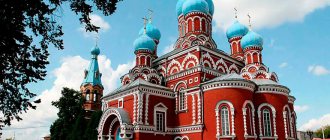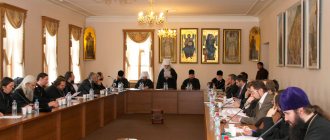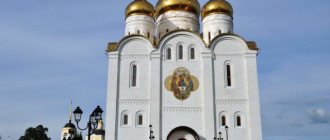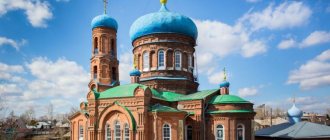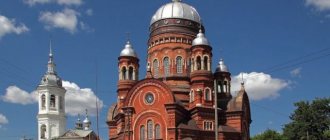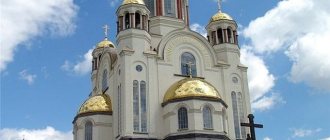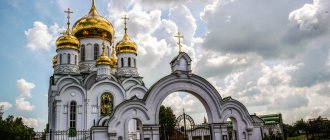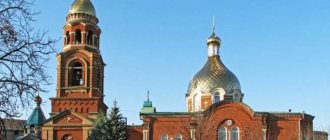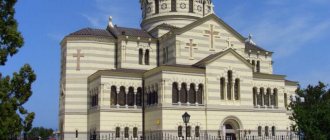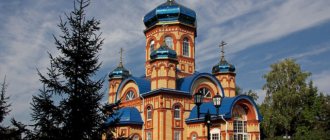| Ufa St. Sergius Cathedral |
Ufa and Sterlitamak Diocese
of the Bashkortostan Metropolis of the Russian Orthodox Church
- Diocesan administration: Russia, 450103, Ufa, st. Sochinskaya, 29
- Tel/fax
- Official site:
- Canonical territory: Ufa, Blagoveshchensk, Gafuriy, Sterlitamak districts of the republic. Bashkortostan
- Cathedrals: Sergius and Mother of God of the Nativity in Ufa, St. Nicholas in Sterlitamak
- On the map: Yandex.Map, Google map
The first traces of Christianity on the territory of the present Bashkortostan Metropolis date back to the 8th centuries.
Faith penetrated here in different ways, the population was mixed - Finno-Ugric, Turkic, Slavic, Hunnic and Iranian origin. A significant proportion of the inhabitants came from Volga Bulgaria, where the Christian faith was widespread. The most influential centers of the spread of Orthodoxy for this region were the Eastern Roman Empire and Novgorod. There is an indication of the presence of Russian colonies along the banks of the Kama in the 13th century (in the area of Menzelinsk, Naberezhnye Chelny and Nikolo-Berezovka) [1]. However, the nomadic way of life and the constant danger of raids by warlike neighbors could not ensure the stability of church life. The Orthodox faith firmly established itself here only in the second half of the 16th century, with the resettlement of the Russian population to these regions, the construction of fortresses, villages, villages, and at the same time churches, monasteries, and chapels. The first monument of Christianity in Ufa was the wooden Trinity Church, built by the archers “on one day” on the Holy Trinity in 1574 - the day of the founding of Ufa.
Until the middle of the 18th century, this land was included in the Kazan diocese, and from 1764 - in the Vyatka diocese.
Establishment of the diocese
An independent diocese with a see in Ufa was first established by decree of Emperor Paul I on September 27, 1799 and opened in early 1800 as the Orenburg and Ufa diocese within the Orenburg province. It included: Ufa, Menzelinsk, Birsk, Belebey, Sterlitamak, Orenburg - from the Kazan diocese; Troitsk, Chelyabinsk, Verkhneuralsk - from Tobolsk.
On March 21, 1859, the diocese was divided into two: Orenburg and Ufa, with centers in the corresponding cities. With the formation of the independent Ufa province in 1865, the boundaries of the dioceses were accordingly clarified.
Soviet period
After the revolution, the diocese divided the share of the Orthodox Church in the USSR and was consistently crushed by the atheistic authorities. At the same time, the post-revolutionary Ufa diocese is characterized by striking differences from the general outline of church history in Soviet Russia, primarily during the period of independent life in 1922-1923, when the temporary Ufa autocephaly was organized. By 1930, all monasteries in the diocese were closed. In 1935, the Ufa diocesan administration was liquidated and the leadership of the diocese was transferred to Bishop Kuibyshevsky. The closure of churches proceeded especially quickly in the second half of the 1930s, so that by 1939, only the Ufa St. Sergius Church was left in operation by the Soviet authorities in the Ufa diocese. All valuables were confiscated.
The turn in the religious situation during the Great Patriotic War was expressed in the revival of the diocese. In 1942, the department was restored, and soon several dozen churches were opened.
A new round of persecution during Khrushchev’s “thaw” again sharply reduced the number of open churches. By 1965, only 17 remained, most of them were nondescript houses of worship, while the temple buildings were destroyed. This situation persisted almost until the collapse of the USSR, when a new revival of church life began.
Modern times
On December 27, 2011, the Neftekamsk and Salavat dioceses were separated from the diocese, together with which the Ufa diocese was included in the newly formed Bashkortostan Metropolis as its center. The department retained its jurisdiction over the Ufa, Arkhangelsk, Beloretsky, Blagoveshchensky, Gafuriysky, Iglinsky, Sterlitamak and Uchalinsky districts in the middle-eastern part of Bashkortostan. After the establishment of the independent Birsk See on July 29, 2021, the Ufa diocese was limited to the Ufa, Blagoveshchensk, Gafuriy and Sterlitamak districts in the center of Bashkiria.
Historical names
- Ufa and Menzelinskaya (March 21, 1859 - 1928)
- Ufa and Davlekanovskaya (1928 - 1944)
- Ufa and Bashkir (1945 - 1952)
- Ufa and Sterlitamak (since 1952)
Statistics
- con. XIX century [2] - 26 dean districts (in Ufa - 2, in the districts: Ufa - 6, Sterlitamak, Birsky, Menzelinsky, Zlatoust - 3 each, in Belebeevsky - 4); monasteries and edinoveriech. churches made up 2 special districts; 366 churches.
- 1912 [2] - 497 churches, 223 chapels and houses of worship; 14 monasteries (6 men's, 8 women's); 1 theological seminary, 1 theological school, 1 diocesan women's school, 320 church schools; 388 libraries at churches; 4 hospitals, 3 almshouses.
- 1913 [2] - 18 monasteries and communities (6 men’s, 11 women’s); 526 churches (7 cathedral, 432 parish, 21 house, 22 affiliated, 6 cemetery); 225 chapels.
- 1919 [3] - 14 thousand 142 students studied in 320 parish schools and literacy schools.
- beginning 1920s [3] - more than 700 churches (including affiliated, Edinoverie and houses of prayer), 16 monasteries, 1 theological seminary, 2 diocesan schools (male and female).
- 1936 [2] – 214 churches
- 1939 [2] – 51 churches
- 1941 [2] - the only functioning church is the Ufa St. Sergius Church (without a priest).
- 1945 [2] - 2 deaneries with churches in Ufa and Sterlitamak
- 1952 [2] – 51 churches
- 1956 - 42 churches
- January 1, 1958 [4] - 41 registered temples/houses of worship.
- 1965 - 17 parishes
- 1970 [2] – 17 churches
- 1990 [3] - approx. 30 parishes
- 1993 [2] - 10 deaneries, approx. 90 parishes
- July 27, 2010 [5] - 279 parishes, 8 monasteries, 253 clergy
- February 2021 - 15 deaneries, 130 parishes, 130 clergy (of which 14 monastics), 3 monasteries (1 men, 2 women) [6]
Bishops
- Porfiry (Sokolovsky) (March 21, 1859 - September 13, 1860)
- Filaret (Malyshevsky) (September 13, 1860 - February 28, 1869)
- Peter (Ekaterinovsky) (April 4, 1869 - November 19, 1876)
- Nikanor (Brovkovich) (December 25, 1876 - December 12, 1883)
- Dionisy (Khitrov) (December 12, 1883 - September 8, 1896)
- Justin (Polyansky) (October 14, 1896 - July 14, 1900)
- Anthony (Khrapovitsky) (July 4, 1900 - April 27, 1902)
- Kliment (Vernikovsky) (May 26, 1902 - November 26, 1903)
- Christopher (Smirnov) (November 26, 1903 - October 17, 1908)
- Nathanael (Troitsky) (October 31, 1908 - April 17, 1912)
- Mikhei (Alekseev) (April 17, 1912 - December 22, 1913)
- Dosifey (Protopopov) (1913) v/u, ep. Volsky
- Evfimy (Lapin) (February 4 - December 4, 1919) high school bishop. Yakut
- John (Poyarkov) ((con. 1922) August 13, 1923 - February 3, 1924, March 14, 1924 - 1928) v/u, bishop. Davlekanovsky
- 1937 - 1942 - under the direction of Bishop Kuibyshevsky
Soviet period and modern times
By 1917, the Ufa branch consisted of about 520 churches and 17 monasteries, but with the arrival of the Bolsheviks, like all of Russia, the Orthodox faith of Bashkiria was subjected to massive repression. During 1919-1930 The diocese is systematically destroyed: all monasteries and churches except the Sergius Church are closed, almost all the leading clergy are destroyed, all church values are confiscated.
In 1935, the episcopal department in Ufa was completely liquidated, but in 1942 it was restored and transferred to the management of one deanery. So the department existed until the Khrushchev wave of repressions, when the confiscation of temple buildings again took place and their number was reduced to 17 throughout the region.
Patriarchal service in the Ufa Cathedral
The remaining churches were in a pitiful state, since the old beautiful churches were either completely destroyed or occupied by cultural centers and other government institutions.
The revival occurred at the end of the existence of the USSR - in 1990, the episcopal see was restored and occupied by Metropolitan Nikon, under his leadership there were only 17 parishes. However, without resistance from the state authorities, things went better for the Ufa department - by 2010 there were already 279 parishes.
And in December 2011, separate ones were separated from the diocese - Neftekamsk and Salavat. Together with the Ufa (center) they formed the new Bashkortostan metropolis.
Diocesan departments
- Religious education and catechesis
- Youth
- By culture
- Missionary
- For prison ministry
- On interaction with the Cossacks
- Working with drug and alcohol addicts
- For work in medical institutions,
- On interaction with the Ministry of Internal Affairs
- On interaction with the Russian Army and the Ministry of Emergency Situations
- For charity and social service
- Sports and military-patriotic education of youth
- Working with Sunday schools
- By canonization of saints
- Pilgrimage and methodological center
The official website of the Ufa diocese has a lot of materials, including a library
The Ufa diocese has an official website. This is a very conveniently designed resource. It feels the influence of antiquity, the centuries-old history that the Russian Church has.
Ufa diocese official website
In addition to a pleasant design, the site widely covers Ufa diocesan news, foundations, and features of the organization.
Anyone can find out what's new in the life of Russian Orthodoxy in Russia. At the same time, for convenience, news settings are provided - for example, read only announcements and announcements, or learn something about the life of the diocese. For those who do not want to immerse themselves in reading, visual alternatives have been invented:
- Photo strip.
- Videotapes.
And there is also more serious information - publications of the Supreme Church Council.
The “ruling bishop” section contains news exclusively about the activities of Metropolitan Nikon.
Other informative sections:
- Shrines and saints;
- Departments;
- Deaneries and parishes.
But not only news and general information are collected on the official website of the Ufa diocese. There are also sections that will be practically useful for the spiritual life of a believer.
For example, there are calendars - two:
- One is church-wide, for all believers who have come to this resource and want to find out what the upcoming dates are related to.
- The second is the diocese calendar, which will be useful for local believers.
Moreover, these are not only dates, but detailed transcripts of what specific holidays and anniversaries are associated with.
But the “library” section may be especially interesting to visitors. In an era when books are mercilessly removed from all Internet resources, keeping them freely available is already perceived as a good deed.
For convenience, a wide thematic list is provided:
- Liturgics;
- Story;
- Liturgical texts;
- Church art;
- Bible.
And other. Perhaps, not every diocese’s website provides such opportunities.
If a visitor gets lost in this variety, the search button will help him out.
No matter what section you are in, it is always in a visible place:
- Contacts;
- Announcements;
- Calendar.
By leaving a comment, you accept the user agreement
Literature
- Ryazantsev, P. G., Address-calendar of persons serving in the Ufa province: (To the Memorial Book of the Ufa Province)
, Ufa, 1873. - Zlatoverkhovnikov, I. G., Ufa Diocese
, Ufa, 1899. - Vasilyeva, O. V., Latypova, V. V., From the history of the Ufa diocese.
Road to the temple , Ufa. 1993. - Mokhov, V.V., Clergy of the Ufa diocese.
Historians of the region: Materials of the 2nd local history conference: [Sb.] , Ufa, 1994. - “History of the Ufa Diocese,” Ufa Diocese of the Russian Orthodox Church: reference guide
[ed.-comp. Egorov P.V., Rudin L.G.], M.: Ufim. Diocese of the Russian Orthodox Church: Society for the Preservation of Lit. Heritage, 2005, 21-24:
Russian Orthodox Church
Part of the Bashkortostan Metropolitanate
Until the middle of the 18th century. the parishes of Bashkiria belonged to the Kazan diocese; from 1764 - to Vyatskaya.
By decree of Emperor Paul I of September 27, 1799, the independent Orenburg and Ufa diocese with an episcopal see in Ufa was established and opened at the beginning of 1800. It included: Ufa, Menzelinsk, Birsk, Belebey, Sterlitamak, Orenburg (from the Kazan diocese); Troitsk, Chelyabinsk, Verkhneuralsk (from Tobolsk). On March 21 (April 2), 1859, the diocese was divided into the Orenburg and Ural diocese, with its center in Orenburg, and the Ufa and Menzelinsk diocese, with its center in Ufa. With the formation of the independent Ufa province in 1865, the boundaries of the dioceses were clarified.
In 1935, the Ufa diocesan administration was liquidated and the leadership of the diocese was transferred to Bishop Kuibyshevsky. The diocese was restored again in 1942 with one deanery.
By the decision of the Holy Synod of December 27-28, 2011 (magazine No. 151) it was included in the Bashkortostan Metropolis; Neftekamsk and Salavat dioceses were separated from the Ufa diocese.
By the decision of the Holy Synod of July 29, 2021 (journal No. 51), the Birsk diocese was separated from the Ufa, Salavat and Neftekamsk dioceses.
Historical reference
Diocese today (as of April 2018)
Deaneries and deaneries
- Annunciation - Archpriest Viktor Ivanov
- Demskoye - Archpriest Viktor Kiselev
- Zatonskoe - Archpriest Vasily Maystruk
- Kuganakskoe - Archpriest Pavel Mironov
- Monastyrskoye - Archimandrite Varlaam (Maksakov)
- Sterlitamak - priest Alexander Krivtsov
- Tabynskoye - Priest Dimitry Medvedev
- Timashevskoe - Archpriest Sergiy Abramov
- Ufa - Archpriest Romil Gareev
- Yurmashskoe - Archpriest Pavel Tikhonov
Monasteries
men's:
- Uspensky St. George 453455, Republic of Bashkortostan, Blagoveshchensky district, village. Usa-Stepanovka; tel.; e-mail; website svyatiekustiki.ru deputy - Archimandrite Varlaam (Maksakov)
women's:
- Blagoveshchensky 453113, Republic of Bashkortostan, Sterlitamak, st. Kalinina, 52; tel.; e-mail; website https://blagstr.cerkov.ru/abbess - Abbess Natalia (Efremova)
- Bogoroditse-Tabynsky 453051, Republic of Bashkortostan, Gafuriysky district, village. Resort; tel. (34740) 2-94-00; e-mail; website https://tabinskaya-ikona.ru/abbess - Abbess Ioanna (Smolkina)
Number of parishes - 92.
The number of clerics is 115, including 11 monastics (ryassophore and mantle).
Social institutions
- Sisterhood of Mercy at the Intercession Church in Ufa 450078, Republic of Belarus, Ufa, st. Mingazheva, 4; tel./fax (347) 273-51-07 head - Elena Vladimirovna Bessmertnova
- Orthodox center for psychological assistance to families at the Spassky Church in Ufa 450000, Republic of Belarus, Ufa, st. October Revolution, 37A leader - Archpriest Roman Tarasov (rector of the temple)
- Society of Doctors at the Resurrection Cathedral in Ufa 450098, Republic of Belarus, Ufa, st. Komsomolskaya, 161; tel. (347) 274-32-94 leader - Archpriest Ilya Aleksankin (rector of the temple)
- Free canteen at the St. Nicholas Church in Ufa 450015, Republic of Belarus, Ufa, st. Vokzalnaya 39A; tel. (347) 256-19-22 leader - Archpriest Pavel Tikhonov (rector of the temple)
- at the Holy Cross Church 450076, Ufa, st. Sawmill, 2; tel. (347) 250-59-31 leader - Archpriest Roman Khabibullin (rector of the temple)
- Center store for receiving and issuing things “Blago” 450105, Republic of Belarus, Ufa, st. Gagarina, 41/2
Mass media
- official website of the Ufa diocese
- official page of the Ufa diocese on the social network “VKontakte”
- official page of the Ufa diocese on the social network “Facebook”
- official channel of the Ufa diocese on YouTube video hosting
- business card website of the Ufa diocese on the Prikhod.ru network
- business card website of the Ufa diocese on the Elitsa network
- "Ufa Diocesan Gazette" (monthly newspaper)
- missionary and apologetic site “Towards the Truth”
- Ufa Deanery website
- Tabyn deanery website
- business card website of the Kuganak deanery
- business card website of the Sterlitamak deanery
- business card website of the Timashevsky deanery
- business card website of the Annunciation Deanery
- business card website of Zatonsky deanery
- business card website of the Yurmash deanery
- business card website of the Dema Deanery
- business card website of the Monastery Deanery
- website of the diocesan department for combating drug addiction and alcoholism
- website of the Ufa Cathedral of the Nativity of the Virgin Mary
- “Resurrection” (monthly newspaper of the Resurrection Cathedral in Ufa)
Educational establishments
There are no diocesan, parish or other church religious and educational institutions that have a state license or accreditation in the diocese.
At the parish level, religious education is carried out:
- in children's Sunday schools (1215 students, 124 teachers)
- diocesan courses for the training of church specialists in the field of catechetical, social and missionary activities (76 students: 43 people - in the evening department, with referrals from Ufa parishes and 33 people - in correspondence, with referrals from the parishes of Sterlitamak, Belebey, Blagoveshchensk, Beloretsk and many rural parishes)
Diocesan courses for the training of church specialists in the field of catechetical, social and missionary activities have been operating in the Ufa diocese since 2010. The courses are open to all interested laymen who have a written blessing from their confessor.
Currently, 86 people are studying in the evening and correspondence courses.
The course curriculum covers 3.5 years of study (7 semesters). The total workload is 2928 hours for the training of catechists, 3296 hours for the training of missionaries and 2872 hours for the training of social workers.
During their studies, course students undergo mandatory practice in parishes: evening classes in Ufa, and correspondence classes in their cities. Students conduct lessons in Sunday schools, catechumens, parish counseling, catechetical courses for adults, and are actively involved in social work. In the summer, students of diocesan courses take part in missionary trips and in Orthodox children's camps. Graduates of the courses work primarily as assistant superiors in catechetical, missionary and social activities.
Currently, the main documents have been prepared for obtaining a license for educational activities in Rosobrnadzor of the Russian Federation for the Republic of Bashkortostan.
Why does a drug addict need compulsory treatment?
The fact is that there is a whole group of synthetic drugs that act primarily on the addict’s brain. When taking such substances, the addict is unable to distinguish between the fantasies of the drug-affected imagination and reality. His own dreams seem much more real to him. An addict who takes such substances (for example, drugs “spice” or “salt”) is in a completely inadequate state. He is capable of causing harm to himself and loved ones, without in any way thinking about the consequences. Thus, addicts are capable of jumping out of a window, following a voice that, as it seems to them, is calling them, and causing serious injury to others, even the closest people, if at the moment it seemed to them that it was a demon or another character posing a threat.
Such cases require immediate compulsory treatment . In these situations, it is the only possible way out.
At the same time, even if the matter has not gone that far, a drug addict is able to realize the full horror of his own addiction only when he is in a sober mind, and not while “high.”
We will come and pick up a drug addict without his consent for treatment
Rehabilitation specialists are ready to meet the wishes of relatives. If the addict does not recognize himself as such, we will have therapeutic conversations with him that will help him realize his own problem and want to get rid of it. Such psychological work is an important part of our unique methodology.
However, even if such conversations do not have any effect, our specialists will take the patient to carry out motivational work in a hospital setting.
Here, far from the usual temptations, you can much more quickly overcome psychological resistance to treatment and begin effective work aimed at ridding the drug addict of his addiction. Relatives of drug addicts often cannot decide what is best:
- hope that the desire to get rid of the destructive passion for drugs will come on its own;
- act actively as soon as the use of psychotropic substances begins.
When making a decision, keep in mind that the shorter the period of use, the greater the chances of returning to a healthy life, and the less damage done to the body.
Compulsory treatment of drug addicts
- this is a real chance to save your loved one who is not able to understand the gravity of the situation in which he finds himself due to drugs.
Drug addiction treatment
Drug addiction treatment in Russia is offered at the public and private levels. Drug clinics, dispensaries and hospitals offer assistance to people addicted to illegal drugs.
Treatment always begins with medications. Withdrawal syndrome is relieved and the body is cleansed. The next stage involves psychological liberation from a destructive habit.
The full course of treatment includes:
- Cleansing the body of toxins.
- Restoration of mental state (communication with a psychologist).
- Reanimation of life skills in a healthy society.
- Assistance in finding and finding a job for a former drug addict.
- Laying down new life values.
By turning to specialized centers, drug addicts have the opportunity to receive full treatment and get rid of their bad habit.
Links
other countries Argentine • Baku • Berlin • Brussels • Budapest • Vienna • Vilna • The Hague • Korsun • Sourozh Autonomous churches Chinese PC Beijing • Xinjiang • Tianjin • Harbin • Shanghai Japanese PC Kyoto • Sendai • Tokyo Self-governing churches Ukrainian PC Alexandria • Baltska • Belotserkovskaya • Berdyansk • Boryspilska • Vinnitsa • Vladimir-Volynska • Voznesenskaya • Volynska • Gorlovska • Dzhankoyska • Dnepropetrovsk • Donetsk • Zhytomyr • Zaporozhye • Ivano-Frankivsk • Izyumska • Kamenets-Podilska • Kamenska • Kyiv • Kirovograd • Konotop • Kremenchug • Krivoy Rog • Luhansk • Lviv • Mogilev-Podolsk • Mukachevo • Nizhyn • Nikolaev • Novokakhovsk • Ovruch • Odessa • Poltava • Rivne • Rovenkovsk • Romensk • Sarnensk • Severodonetsk • Simferopol • Sumy • Ternopil • Tulchin • Uman • Feodosia • Kharkov • Kherson • Khmelnitsky • Khust • Cherkasy • Chernihiv • Chernivtsi • Shepetovsk
Human Rights Center of Moldova Beltsy • Edinet • Cahul • Kishinevskaya • Tiraspol • Ungheni
Latvian PC Daugavpilsskaya • Rizhskaya Estonian Human Rights Center Narvskaya • Tallinskaya ROCOR Berlin • British • East American • Geneva • Montreal • San Francisco • Sydney • Chicago • South American Exarchates Belarusian Exarchate Bobruisk • Borisov • Brest • Vitebsk • Gomel • Grodno • Lida • Minsk • Mogilev • Molodechno • Novogrudok • Pinsk • Polotsk • Slutsk • Turov
Metropolitan districts Kazakhstani Astanaiskaya • Karaganda • Kokshetau • Kostanay • Pavlodar • Petropavlovsk • Ural • Ust-Kamenogorsk • Chimkent
Central Asian Bishkek • Dushanbe • Tashkent • Patriarchal parishes in Turkmenistan
Patriarchal parishes of the Moscow Patriarchate Italy • Canada • USA • Finland
Medication coding for drugs: features
Medication coding has not lost its relevance for a long time. This is a common and popular procedure. A special drug is injected into the patient's body. It stops the effect of the drug, resulting in a sharp deterioration in health. The patient's craving for drugs is eliminated.
For the technique to work, the patient needs to give up drugs for several days before visiting the center. Body cleansing and detoxification are mandatory. Withdrawal takes place under the full supervision of a doctor and specialists. The drug for coding is selected individually, taking into account the characteristics of the body and the health of the patient. The Private Medic 24 clinic offers low and affordable prices. Each client can count on an individual approach, urgent and fast assistance
Detoxification, treatment and rehabilitation of drug addicts in Ufa
Patients facing addiction in Ufa can undergo treatment for binge drinking or drug rehabilitation from specialists at the Hangover Service clinic.
An integrated approach and a guarantee of complete recovery during all stages of therapy allowed a large number of people in the city to return to a happy, active life.
Patients receive:
You can get information about prices, conditions, as well as compulsory treatment of drug addicts free of charge and anonymously in consultation with specialists of the Hangover Service clinic. To call a drug treatment team, you can call our toll-free number 24 hours a day.
Shrines
Among the important and significant shrines of Bashkiria, the main one is the Cathedral of the Nativity of the Virgin Mary in Ufa. This tall sky-blue temple is located in the Kirov region and is the most spacious in the republic - it can accommodate up to several thousand parishioners at a time.
Interior of the cathedral church in Ufa
The cathedral houses the relics of the saints:
- Nicholas the Wonderworker;
- Nina Gruzinskaya;
- Panteleimon the Healer;
- St. George the Victorious;
- Elizabeth and Barbara;
- Sergius of Radonezh.
Among the shrines of the temple there are also images: icons of the Life-Giving Trinity and the Last Supper. Pilgrims can visit the temple any day of the week.
Another significant shrine is the Assumption St. George Monastery. Relatively young (established in 1901), it is the largest in Bashkiria. During the Soviet era, the monastery was empty, but in 1994 it was opened and restoration work was carried out. A part of the Life-Giving Tree of the Holy Cross, the relics of the Apostle Luke and part of the Oak of Mamre are kept here.
On a note! Due to the significance of the relics, the monastery became a mandatory item on the list of pilgrims of the diocese, despite the fact that it is located 100 km from the regional center.
A must-see is also the Church of the Savior Not Made by Hands, which was revived twice: first after a terrible fire in 1821 and after complete closure and destruction in 1929. The Church of the Savior was originally built, which was erected in honor of the icon of the same name.
During the procession of the Cross, the image of the Savior Not Made by Hands suddenly rose - in honor of this event, a temple was erected. After the formation of the USSR, the buildings were transferred to a cinema, and then used as a hostel. Part of the building collapsed, and the architecture everywhere was badly damaged.
Church of the Savior Not Made by Hands in Ufa
In 1994, the temple returned to the Russian Orthodox Church and in 2004 its complete restoration was completed. Today, prayer services are held here on Sundays with the participation of the icon of the Savior Not Made by Hands, and the entire building has become a monument of history and culture.
The pilgrimage movement is extremely developed in Bashkiria, therefore the diocese has a special department that will help in organizing trips of any complexity and duration.
